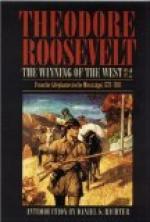Hamilton had no fear of the inhabitants themselves, for the fort completely commanded the town. To keep them in good order he confiscated all their spirituous liquors, and in a rather amusing burst of Puritan feeling destroyed two billiard tables, which he announced were “sources of immorality and dissipation in such a settlement.” [Footnote: Do.] He had no idea that he was in danger of attack from without, for his spies brought him word that Clark had only a hundred and ten men in the Illinois county [Footnote: Do. “Fourscore at Kaskaskia and thirty at Cahokia."]; and the route between was in winter one of extraordinary difficulty.
He Goes into Winter Quarters.
He had five hundred men and Clark but little over one hundred. He was not only far nearer his base of supplies and reinforcements at Detroit, than Clark was to his at Fort Pitt, but he was also actually across Clark’s line of communications. Had he pushed forward at once to attack the Americans, and had he been able to overcome the difficulties of the march, he would almost certainly have conquered. But he was daunted by the immense risk and danger of the movement. The way was long and the country flooded, and he feared the journey might occupy so much time that his stock of provisions would be exhausted before he got half-way. In such a case the party might starve to death or perish from exposure. Besides he did not know what he should do for carriages; and he dreaded the rigor of the winter weather. [Footnote: Haldimand MSS.; in his various letters Hamilton sets forth the difficulties at length.] There were undoubtedly appalling difficulties in the way of a mid-winter march and attack; and the fact that Clark attempted and performed the feat which Hamilton dared not try, marks just the difference between a man of genius and a good, brave, ordinary commander.
He Plans a Great Campaign in the Spring.
Having decided to suspend active operations during the cold weather, he allowed the Indians to scatter back to their villages for the winter, and sent most of the Detroit militia home, retaining in garrison only thirty-four British regulars, forty French volunteers, and a dozen white leaders of the Indians [Footnote: Do. B. Vol. 122, p. 287. Return of Vincennes garrison for Jan. 30, 1779.]; in all eighty or ninety whites, and a probably larger number of red auxiliaries. The latter were continually kept out on scouting expeditions; Miamis and Shawnees were sent down to watch the Ohio, and take scalps in the settlements, while bands of Kickapoos, the most warlike of the Wabash Indians, and of Ottawas, often accompanied by French partisans, went towards the Illinois country. [Footnote: Hamilton’s “brief account,” and his letter of December 18th.] Hamilton intended to undertake a formidable campaign in the spring. He had sent messages to Stuart, the British Indian agent in the south, directing him to give war-belts to the Chickasaws,




